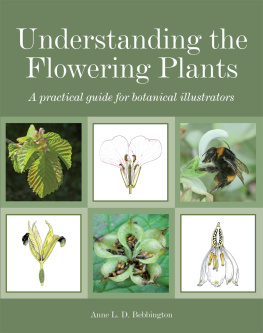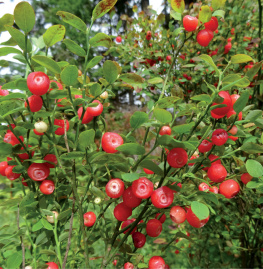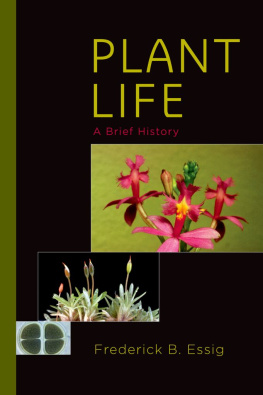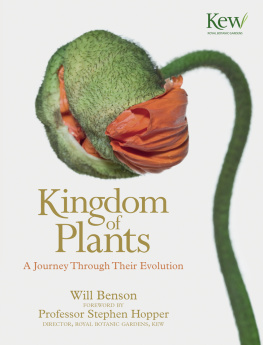
Understanding the Flowering Plants
A practical guide for botanical illustrators
Anne L. D. Bebbington

THE CROWOOD PRESS
First published in 2014 by
The Crowood Press Ltd
Ramsbury, Marlborough
Wiltshire SN8 2HR
www.crowood.com
This e-book published in 2015
Anne Bebbington 2014
All rights reserved. No part of this publication may be reproduced or transmitted in any form or by any means, electronic or mechanical, including photocopy, recording, or any information storage and retrieval system, without permission in writing from the publishers.
British Library Cataloguing-in-Publication Data
A catalogue record for this book is available from the British Library.
ISBN 978 1 84797 759 5
Frontispiece: A worker Early Bumblebee nectaring on the flower of a Dusky Cranes-bill (Geranium phaeum)
Dedication
For Mary Brewin, my co-tutor in running the first Botany for Botanical Artists course in 2010. Without her, this course would not have happened, nor been such a success.
Acknowledgements
I am deeply indebted to my husband John, not only for taking the majority of photographs in this book, but also for his tremendous help in checking all the material and for his support and encouragement. I am very grateful to Mary Brewin, Jan Cheshire, Catherine Day, Ros Franklin and Ken Victor for permission to use their artwork, and to Melvin Grey, Robert Sharrad, David and Madeleine Spears and Ruth Thomas for use of their photographs. I thank Science and Plants for Schools (SAPS) for permission to include the simple idea for measuring tree height.
All photographs except those accredited otherwise are by John Bebbington FRPS.
All artwork except that accredited otherwise is by the author.
CONTENTS
EVOLUTION; MAJOR GROUPS IN THE PLANT KINGDOM; THE FLOWERING PLANTS AND THEIR CLASSIFICATION; MAJOR GROUPS WITHIN THE FLOWERING PLANTS; PLANT NAMES; WRITING PLANT NAMES
|
DECISIONS TO MAKE BEFORE YOU START; RESEARCHING YOUR SUBJECT; CHOOSING AND COLLECTING MATERIAL; LOOKING AFTER YOUR PLANT MATERIAL; BOTANICAL ILLUSTRATION AND ARTISTIC LICENCE; KEEPING A RECORD
|
TOOLS; PRACTICAL TIPS AND TECHNIQUES; INDICATING SIZE; PHOTOGRAPHY AND BOTANICAL ART; COMPUTERS AND SCANNERS
|
THE PARTS OF A PLANT; PHOTOSYNTHESIS; RESPIRATION; MINERAL NUTRITION; PARASITES AND SAPROPHYTES; TRANSPORT; TRANSPIRATION AND THE CONTROL OF WATER LOSS; GROWTH; PLANT BEHAVIOUR
|
THE BASIC STRUCTURE OF THE LEAF; SIMPLE AND COMPOUND LEAVES; LEAF ATTACHMENT; LEAF ARRANGEMENT; CHOOSING LEAVES TO ILLUSTRATE; LEAVES WITH SPECIAL ADAPTATIONS; INSECTIVOROUS PLANTS
|
MAIN FUNCTIONS; DISTINGUISHING ROOTS FROM STEMS; EXTERNAL FEATURES OF ROOTS AND ROOT SYSTEMS; ADVENTITIOUS ROOTS; EXTERNAL FEATURES TO OBSERVE ON STEMS; SPECIALIZED ROOTS AND STEMS; LIVING IN VERY DRY PLACES CACTI, SUCCULENTS AND OTHERS
|
LIFE SPANS; SURVIVING AND REPRODUCING; VEGETATIVE REPRODUCTION; ORGANS OF VEGETATIVE REPRODUCTION; GARDENING AND THE REPRODUCTION OF PLANTS
|
EXAMINING A FLOWER; THE BASIC STRUCTURE OF A FLOWER; SEPARATE MALE AND FEMALE FLOWERS; FLORAL FORMULAE, DIAGRAMS AND HALF FLOWERS; THE INFLORESCENCE
|
THE GENETICS, AN INTRODUCTION; CROSS-POLLINATION AND SELF-POLLINATION; THE TRANSFER OF POLLEN; STUDYING POLLINATION MECHANISMS; INSECT POLLINATION SOME EXAMPLES
|
DESCRIBING FRUITS; THE FRUIT ITS DEVELOPMENT AND STRUCTURE; THE MAIN FRUIT TYPES; FALSE FRUITS OR PSEUDOCARPS; DISTINGUISHING FRUITS FROM SEEDS; SOME POPULAR SUBJECTS FOR ILLUSTRATION; FRUIT AND SEED DISPERSAL
|
THE STRUCTURE OF SEEDS; DORMANCY; GERMINATION; IDENTIFYING SEEDLINGS
|
WHAT IS A TREE? TREES IN WINTER; TWIG FEATURES; BUD STRUCTURE; PRICKLES, SPINES AND THORNS; DIAGNOSTIC FEATURES; WINTER TWIGS WITH FLOWERS
|

INTRODUCTION
Botanical art lies along a spectrum linking art and science. As a botanist, my illustrations are most often done for scientific purposes but I greatly value and appreciate the knowledge and skills of those whose work has its origins in the world of art.
Part of my botanical training was a regular requirement to produce drawings and diagrams. If you can draw it, you understand it was the maxim. This stimulated and guided my investigations and has given me a lifelong fascination with the intricacies of how plants are put together and how they work. It also gave me a real appreciation of the value of illustration to a botanist.
In 2004 Michael Hickey, an accomplished artist as well as a very knowledgeable botanist, founded the Institute for Analytical Plant Illustration (IAPI), an excellent forum for botanists and artists to meet and learn from each other. It was through IAPI that Mary Brewin and I came together to run a series of practical workshops. Our aim was to help botanical artists to gain a better understanding of the flowering plants and so inform their artwork, and also to share ideas about illustration techniques appropriate to different botanical subjects. An important part of the learning process was the completion of a self-assessment project between the workshops, designed not only to help students to assess their understanding but to encourage them to ask questions and research their subjects.
This book is based on material from the course, concentrating on the structure of the flowering plants and the role that different parts play in the plants success and survival in its natural environment. I hope not only that those who illustrate plants will find this book useful, but also that it will help to make botanical art in general more interesting and enjoyable.


PREFACE
About the book
Although written particularly with botanical artists in mind, this book should also help anyone wishing to gain a greater understanding of the flowering plants. It starts with advice on how to approach a botanical study and introduces useful practical techniques, tools and equipment. This is followed by an explanation of the terms used to describe the main parts of a flowering plant and its living processes. Succeeding chapters take each part of the plant in turn and describe their basic structure and the role they play in the life of the plant. Features of particular importance, which should be carefully observed, are highlighted. Suggestions for projects are made at the end of each of these chapters. These can be used if you wish to help assess your understanding of the chapters contents or can be used to stimulate ideas for a new project. Appendix I gives advice on carrying out these projects, together with two completed examples.
For those who are just looking for information about a specific part of the plant the contents page gives an outline of the topics covered in each chapter, allowing you to dip in and out of the book.
Next page









